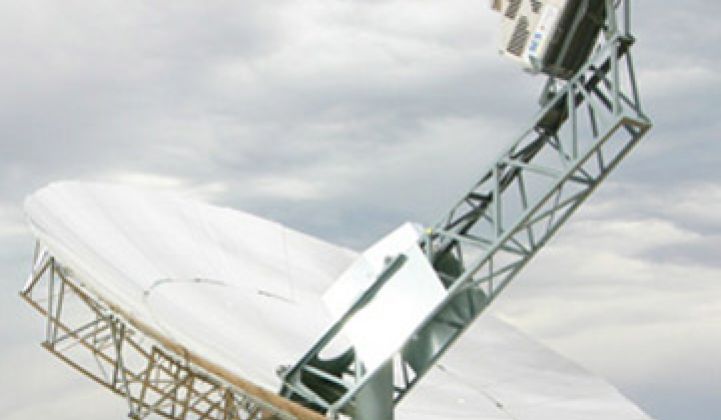In the California desert, Stirling technology has been placed on hold.
NTR -- an Irish conglomerate that owns Stirling Energy Systems and Tessera Solar -- has decided to hold off on the two solar thermal projects those companies have tried to develop. The two projects, slated for construction in the Imperial Valley and the Mojave, would be capable of producing around 1.3 gigawatts of power. Unfortunately, the projects would also cost quite a bit of money.
The Irish Times reported that the cost of the two projects and the write-downs associated with them contributed to the company's 210 million euro loss for the year.
"The projects would require an investment of €2 billion and the company decided to hold off until economic conditions and capital markets’ appetites for such investments improved," the Irish Times wrote in a report from NTR's annual shareholders' meeting.
Earlier this month, we wrote about how Stirling, which has created a mirrored dish with a Stirling engine that can generate 25 kilowatts of power, and Tessera, a power plant developer, were in trouble. Stirling CEO Steve Cowman and other executives had recently left Stirling. Layoffs had also occurred at Tessera. While the company declined to comment, sources close to Stirling and Tessera confirmed Cowman's departure and that layoffs had taken place. NTR's public statements that the two thermal projects are in a holding pattern further confirm the turmoil.
The problem? Solar thermal plants aren't as attractive as they were in 2007. Back then, solar thermal was the technology of choice for big solar parks. Declining prices of silicon and silicon solar panels, however, have caused developers and utilities to switch over to building these with PV panels.
In 2010, the price to build a solar thermal park with troughs, power towers or dish engines runs between $5.00 and $6.55 per watt. On the other hand, utility-scale solar module projects can squeak through at less than $3.50 per watt, as we noted in an article in October. One of the big symbols of this shift came when First Solar, the big PV maker, took over a project from thermal specialist Ausra in 2009 and turned it into a PV project. The Imperial Valley and Calico plants are top-tier thermal projects, too. California utilities have already agreed to purchase the power from them, assuming they can get built. Their problems are really symbolic of the challenges the whole sector faces.
Solar thermal could make a comeback. Thermal plants can produce large amounts of power consistently. Some also argue that the grid has an easier time taking power from large thermal plants than from thousands of independent solar panel installations. Many solar thermal plants can also produce heat after the sun goes down, because heat, unlike light or electricity, can be stored economically. Still, the circumstances at the moment and the cost/trend lines favor PV.
Stirling and Tessera, though, face additional problems. To build the Calico plant in the Mojave, the companies would essentially need a U.S. Treasury grant that would cover 30 percent of the cost. But to qualify for the grant, work would have to begin before the end of the year or the companies would have to buy 5 percent of the equipment for the project, according to my colleague Brett Prior of GTM Research. And to get that far, the companies would likely need to raise an estimated $200 million in equity and $160 million in debt before the end of this year and qualify for a conditional loan guarantee from the federal government.
Ugh is the technical financial term for that situation.
Stirling engines also tout more moving parts than other solar thermal technologies and, unlike most other solar thermal technologies, cannot inherently store heat. Still, right now, price rules and solar thermal is not in favor like it once was.
So what will happen? First Solar has been the lead vulture and carrion-consumer in solar. Besides buying the Ausra project, it also bought two large projects from Optisolar after that company went swirling down the S-bend.
Another potential buyer: NRG. The solar subsidiary of the Princeton, New Jersey-based power producer is working with SunPower on a 250-megawatt PV plant and also invested in the solar thermal project in Ivanpah that will use technology from BrightSource Energy.



